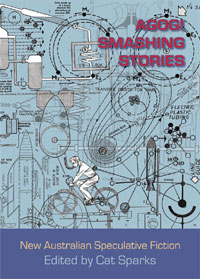The 2005 Snapshot
Australian Speculative Fiction: writers, editors, publishers
Cat Sparks
Cat Sparks
Interview by Ben Peek
 Cat Sparks is the owner of Agog! Press. She also edited and published the Ditmar nominated Agog! Smashing Stories from Agog! Press and has just released the giant monster anthology Daikaiju!, edited by Robert Hood and Robin Pen, and featuring cover art by Bob Eggleton.
Cat Sparks is the owner of Agog! Press. She also edited and published the Ditmar nominated Agog! Smashing Stories from Agog! Press and has just released the giant monster anthology Daikaiju!, edited by Robert Hood and Robin Pen, and featuring cover art by Bob Eggleton.
1) In Australia, Agog! Press has been, to all appearances, quite the success. Your anthologies have been critically well received, been embraced by readers, and provided a venue where new authors can emerge. From a business standpoint, however, what are the realities that are faced for each project?
Nobody ever got rich running a small press. Nobody ever stayed sane either. The main problem faced by small presses is distribution: how to get your books out there into the marketplace. Distribution companies take 70% or more of the cover price. Small presses simply can't afford to use them. This means we have to hand-sell our books to individual store managers who, if they agree to take them, will usually take a handful on consignment basis. A print run of 1500 books doesn't actually cost all that more to produce than a run of 500 due to the different printing processes involved (offset for 1500, digital for 500). But the problem then becomes how to shift 1500 books from out of your lounge room without a distributor?
Seriously, if I could find a distributor that would do the job properly, I'd go the bigger print run and pay the 70% just to see the books on the shelves. But there are so many horror stories. So many small presses have gone up against the wall by doing just this. I can't afford to risk it. I don't have the cash.
I got into the small press game with my eyes wide open. I knew several small press publishers and I asked them all for advice first up. Most of them tried to talk me out of Agog! before it even got off the ground. But I persisted with it despite the economic realities because the anthologies I wanted to read were not being produced in Australia. I plan to keep on doing it till it's not fun any more and then I'll stop.
2) How much time do you spend with the design of a book as an object,and what goes into consideration here?
I was a graphic artist long before I was a writer or editor. Just as I had a clear vision of what I wanted the stories in the Agog! Anthologies to be like, I had a pretty good idea of what I wanted the books to look like too. Crappy design, layout and cover art is all too common in the small press universe ... and there is no excuse for it. If a book doesn't look shit hot then its not going to be able to compete. No one will pick it up, let alone part with cash for it ... and, indeed, why should they?
After Agog! Fantastic Fiction came out, I took into consideration the opinions and advice of booksellers as to where the title lettering on the jacket should go for maximum readability on the shelf. My favourite of my covers is Terrific Tales. I loved the idea of a giant face staring out at the readers looking ... well ... agog!. This is the cover I have had the most favourable response to. For Smashing Stories I wanted something scientific in a dodgy kinda way. I love weird science. And I love my Agog! covers.
3) What kind of work do you think is being embraced and what work has a more difficult home to find in the Australian scene these days?
I believe there is still too much substandard material being accepted for publication ... and by substandard I mean boring stuff, regardless of its subgenre or classification. This is not because the good stories aren't out there. I think it is because of editorial inexperience in some cases, and the use of committees in others. I really don't believe in art by committee. You always end up with something more boring than it might have been. It is not always a matter of saying yes or no to a submission. Sometimes you have to work with an author to make a story shine.
There are many more highly skilled and qualified editors than me out there, but I believe my strength is my taste. I reckon I can spot the good stuff. I don't always choose stories that I personally like for publication -- sometimes I pick a story because it's well crafted, or clever, or powerful. Four of my least favourite stories in Smashing Stories have been nominated for awards. Go figure.
4) You're dead. Oddly, you were murdered by children who gave you poisoned milk. Anyhow, you go to Heaven (assuming you believe, blah blah) and you see God. You say?
Oh wow. Who'd have thought... truth is stranger than... and thanks for letting me in!
5) Favourite swear word?
Most definitely fuck, only I don't think of fuck as being a swear word as such. I use it as an indicator of passion to punctuate my sentences. Some sentences fucking need it, you know? Sometimes you just can't get your fucking point across any other way.
Recently I have become attracted to the term "arsy cunt" to describe a particular kind of person. Arsy cunt. I love it. Gonna put that one on a t-shirt.
©2006 Go to top

